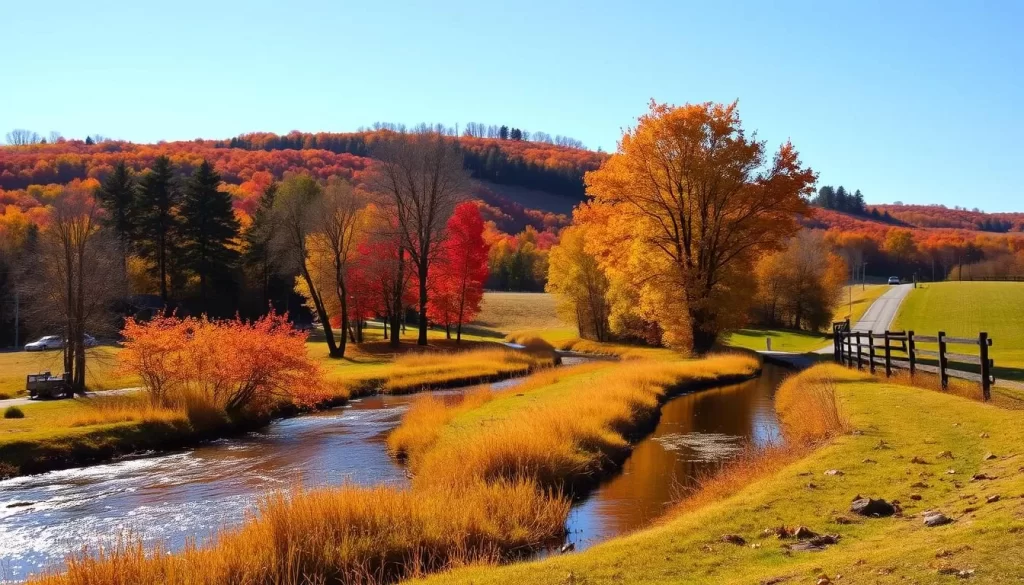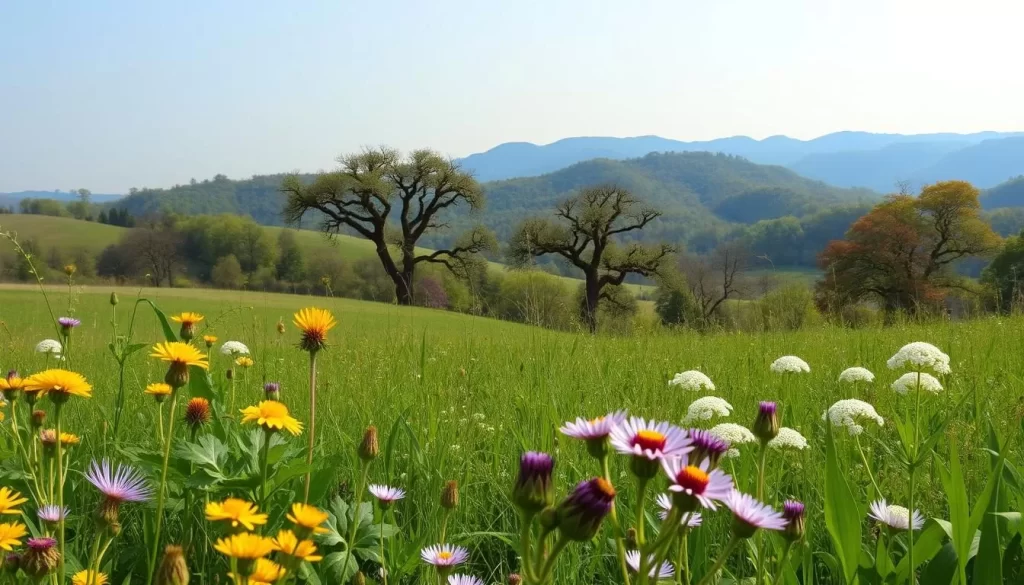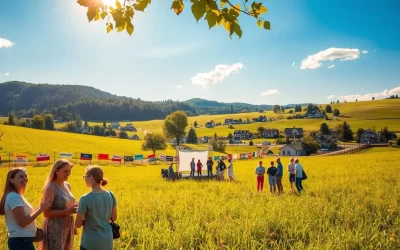Planning a trip to Kentucky can be a delightful experience, but it’s essential to consider the state’s unique weather patterns to make the most of your visit.
The Bluegrass State’s climate varies significantly throughout the year, with each season offering distinct experiences for travelers seeking outdoor activities, cultural events, or natural beauty.
Understanding the weather cycles in Kentucky helps you plan a trip that aligns with your preferences, whether you’re drawn to the vibrant fall foliage, spring horse racing events, summer festivals, or winter attractions.
By knowing the best time to visit, you can enjoy the state’s attractions without the weather being a hindrance, making your experience even more enjoyable.
Understanding Kentucky’s Unique Weather Patterns
Kentucky’s weather is known for its unpredictability, making it essential to understand the patterns that shape the state’s climate. This understanding is crucial for travelers to plan their trip effectively and make the most of their experience.
Geographical Influences on Kentucky’s Climate
Kentucky’s geography plays a significant role in shaping its climate. The state’s location in the southeastern United States, with its mix of mountains, valleys, and plains, contributes to its diverse weather patterns. The Appalachian Mountains to the east and the Ohio River Valley to the west influence the climate, with the mountains typically experiencing cooler temperatures and the valley region having a more moderate climate.
| Region | Climate Characteristics | Temperature Range |
|---|---|---|
| Appalachian Mountains | Cooler temperatures, higher precipitation | 40-70 degrees F |
| Bluegrass Region | Moderate climate, mild winters | 50-80 degrees F |
| Ohio River Valley | Moderate climate, humid summers | 50-90 degrees F |
Seasonal Variations and Unpredictability
Kentucky experiences four distinct seasons, each with its unique weather patterns and challenges. Spring brings rapid temperature fluctuations, while summer is characterized by heat and humidity. Fall offers the most stable and pleasant weather, making it a favorite among visitors. Winter, on the other hand, can be unpredictable, with temperatures ranging from mild to extremely cold.
Understanding these seasonal variations is key to planning a successful trip to Kentucky. By knowing what to expect, you can pack accordingly and make the most of your experience. For instance, if you’re visiting in early spring or late fall, be prepared for unexpected temperature changes, as intraday temperatures can vary by 30 degrees F or more.
Fall in Kentucky: The Prime Season for Visitors
If you’re planning a trip to Kentucky, fall is an excellent choice, with its pleasant weather and array of outdoor activities. The state’s natural beauty is on full display during this season, making it a great time to explore.
September and October: The Golden Months
September and October are considered the golden months in Kentucky’s fall season. September is historically the driest month in Lexington, making it ideal for outdoor events and activities. As October progresses, the fall foliage reaches its peak, typically in mid-to-late October, transforming the landscape into a breathtaking canvas of red, orange, and gold.
- The comfortable fall temperatures create perfect conditions for hiking, horseback riding, and other outdoor activities that let you fully appreciate Kentucky’s natural beauty.
- Fall brings ideal weather for exploring Kentucky’s famous bourbon distilleries, where you can enjoy tours and tastings without the summer heat or winter chill.

Fall Foliage and Comfortable Temperatures
The fall foliage in Kentucky is a major draw for visitors. The average temperature in October is around 58 degrees F, but it’s not uncommon for highs to reach the 80s during the day while lows drop below freezing at night. This variability means you’ll need to pack layers for your trip to ensure you’re comfortable during evening activities.
- The pleasant temperatures make fall the perfect season for attending outdoor festivals and events that showcase Kentucky’s rich cultural heritage.
- While daytime temperatures remain comfortable, you’ll want to be prepared for the drop in temperature after sunset, especially in late October.
Overall, the fall season offers a unique experience in Kentucky, with its mix of natural beauty, outdoor activities, and cultural events. It’s a great time to visit, with something for everyone.
Spring in Kentucky: Blooms, Showers, and Racing
As spring unfolds in Kentucky, the state transforms into a vibrant landscape of blooms, showers, and exciting events. This season is a great time to experience the state’s natural beauty, horse culture, and outdoor activities.
Weather Patterns from March to May
During spring, Kentucky’s weather transitions from the chill of winter to the warmth of summer. March can be quite unpredictable, with temperatures ranging from cool to mild. April brings more stability, with gentle temperatures and fewer cold snaps. May is typically warm, with average highs in the 70s and 80s (°F).
Spring showers are a characteristic feature of this season, contributing to the lush greenery and blooming flowers. However, the rain is usually not persistent, allowing for a good balance between wet and dry periods.
Spring Events and Outdoor Activities
Spring is an excellent time to enjoy outdoor activities in Kentucky. The season hosts various events centered around the state’s horse culture, including the Keeneland Spring Meet in April. This event offers a chance to experience thoroughbred racing in a historic setting, complete with southern traditions and pageantry.
Other notable events include the Saint Patrick’s Day parade in Lexington, which celebrates the city’s Irish heritage. As the weather warms up, outdoor activities such as hiking, water sports, and attending outdoor festivals become more popular. You can enjoy hiking in Kentucky’s state parks, which burst with wildflowers and renewed greenery during spring.
- The Kentucky Derby, held on the first Saturday in May, is a world-famous event that attracts visitors from around the globe.
- The Keeneland Spring Meet offers a unique experience with thoroughbred racing and tailgating parties.
- Spring hiking opportunities abound in Kentucky’s state parks and natural areas.
- Outdoor festivals celebrating bourbon, bluegrass music, and other aspects of Kentucky’s culture begin to appear on the calendar.
- Water activities on Kentucky’s lakes and rivers are ideal during spring, as temperatures warm but before the summer crowds arrive.
Summer Heat and Humidity in the Bluegrass State
The Bluegrass State comes alive in the summer with a mix of heat, humidity, and exciting activities for the whole family. As the temperature rises, many of the best restaurants in Lexington open their patios, and the city’s social scene begins to buzz.
Numerous festivals start up around the city, making summer a great time for those who enjoy outdoor events. The Lexington Farmer’s Market in the 5/3 Pavilion is busier than ever on Saturdays, offering a variety of fresh produce and artisanal food products.
Managing the Hot Kentucky Summers
While the summer heat and humidity can be challenging, there are ways to manage the discomfort. Staying hydrated, seeking shade, and enjoying air-conditioned spaces are a few strategies to beat the heat. Many attractions and museums in Kentucky offer indoor activities that are perfect for hot summer days.
Summer Festivals and Water Activities
Despite the heat, summer is a great time to enjoy Kentucky’s outdoor fun activities. The Festival of the Bluegrass, held at the Kentucky Horse Park, typically in June, celebrates Kentucky’s musical heritage with multiple stages and camping options. Water activities like boating, fishing, swimming, and paddling are also popular during the summer months, with many lakes and rivers across the state.
Other notable summer events include the Thursday Night Live series in Lexington, which offers live music and socializing, and the Woodland Art Fair, which attracts over 70,000 attendees to admire and purchase art from across the country. The Crave Food Festival is another highlight, featuring local restaurants and live entertainment.
Winter in Kentucky: Surprising Cold Snaps and Festivities
Winter visits Kentucky with a chill, but the state’s festive atmosphere keeps the spirit high. You can experience the unique blend of cold snaps and holiday festivities that make Kentucky special during this time.
Temperature Ranges and Snowfall Expectations
Kentucky’s winter temperatures vary, with averages ranging from 25°F to 45°F. Snowfall is a regular occurrence, with some areas receiving more snow than others. You should be prepared for the cold and potential snowfall when planning your trip.
Winter Events and Indoor Attractions
Despite the cold, Kentucky offers a variety of winter events and indoor attractions that make the season enjoyable. You can visit the Kentucky Horse Park for the Southern Lights drive-through holiday display, which transforms the equestrian facility into a winter wonderland. Additionally, the Lexington Opera House hosts a Chinese New Year celebration, featuring traditional music, dance, and acrobatics.
You can also explore Kentucky’s many indoor attractions, such as museums, distilleries, and historic homes. These provide a warm shelter from the cold and offer a glimpse into the state’s rich history and culture. When in Kentucky during winter, you can enjoy fun activities like holiday shopping at the local malls and boutiques, though be sure to plan around potential traffic congestion.
Kentucky, United States: Best Months for a Weather-Savvy Trip
Understanding Kentucky’s weather patterns is crucial for planning a successful and enjoyable trip. The state’s climate varies significantly throughout the year, with different months offering unique conditions that can either enhance or detract from your travel experience.
Ranking the Months for Optimal Weather Experience
To determine the best time to visit Kentucky, it’s essential to consider the weather conditions across the different months. September and October stand out as particularly pleasant, with warm days, cool nights, and minimal rainfall.
The spring season, encompassing April and May, is another favorable period, with mild temperatures and vibrant flora due to the abundant rainfall.
| Month | Average Temperatures (°F) | Average Rainfall (inches) |
|---|---|---|
| January | 34 | 3.5 |
| February | 38 | 3.2 |
| March | 48 | 4.5 |
| April | 58 | 4.2 |
| May | 67 | 4.8 |
Month-by-Month Weather Overview
Kentucky’s weather is known for its variability. Here’s a breakdown of what to expect each month:
January and February are the coldest months, with temperatures ranging from the mid-20s to low 40s Fahrenheit. March begins the transition to spring, with gradually warming temperatures but remains unpredictable.

June through August deliver consistent warmth, with average temperatures in the 70s and 80s Fahrenheit, though humidity levels peak during these months. September and October offer the most pleasant conditions, with warm days, cool nights, and the lowest average rainfall.
Exploring Kentucky’s Outdoor Attractions by Season
As the seasons change, Kentucky transforms into a haven for outdoor enthusiasts. The state’s diverse landscapes and natural wonders make it an ideal destination for those seeking outdoor adventures and fun in various activities throughout the year.
State Parks and Natural Wonders
Kentucky is home to numerous state parks and natural wonders that spot diverse wildlife and ecosystems. These areas provide a serene backdrop for visitors to engage in various activities. The state’s natural beauty is particularly evident in its many parks, such as Red River Gorge and Natural Bridge State Park, which offer stunning landscapes and outdoor experiences.
The changing seasons enhance the allure of these natural attractions. In the spring, the blooming flora creates vibrant colors, while autumn brings a kaleidoscope of foliage. Visitors can spot unique geological formations and enjoy the tranquility of the natural surroundings.
Seasonal Outdoor Activities
Kentucky’s rotating calendar of seasonal outdoor activities caters to various interests and enthusiasts. In the spring, enthusiasts can enjoy birdwatching as migratory species return. Summer is ideal for water activities on Kentucky Lake and Lake Barkley, making them a popular spot for boating and fishing.
During fall, the spectacular foliage attracts hikers and photographers to the state’s trails and scenic byways. In winter, the landscape transforms into a haven for eagle watching, particularly at Kentucky Lake, where bald eagles congregate. This variety of seasonal activities ensures that there’s always something new to experience in Kentucky.
Kentucky’s Cultural Calendar: Planning Around Major Events
Kentucky’s event scene is a mix of tradition, excitement, and southern hospitality, making it a great destination for travelers. Whether you’re a sports enthusiast or someone who enjoys cultural festivals, Kentucky has something to offer.

Annual Festivals and Celebrations
Kentucky hosts a variety of festivals throughout the year, showcasing its rich cultural heritage. You can experience the state’s vibrant culture by attending events like the Keeneland Spring Meet, which is a three-week celebration of thoroughbred racing in April. The tailgating parties and southern hospitality make it a unique experience for enthusiasts.
Other notable events include various cultural festivals that take place in different parts of the state, offering a glimpse into Kentucky’s diverse traditions.
Sporting Events and Horse Racing Seasons
Kentucky’s sporting calendar is centered around its famous horse racing traditions, drawing enthusiasts from around the world. The Kentucky Derby at Churchill Downs on the first Saturday in May is the premier sporting event in the state, offering an unparalleled experience of tradition, fashion, and world-class horse racing.
In addition to horse racing, college sports create excitement throughout the state, with University of Kentucky basketball games in Lexington and University of Louisville sporting events drawing passionate fans to these cities. You can spot the excitement in the city as fans gather to cheer on their teams.
For outdoor sports enthusiasts, Kentucky offers seasonal hunting and fishing opportunities regulated by specific seasons and conservation guidelines, making it a great spot for nature lovers.
Packing Essentials for Kentucky’s Variable Weather
The ever-changing weather in Kentucky demands careful planning and packing to ensure a great experience. Whether you’re visiting during the peak of winter or the warmth of summer, being prepared for unexpected weather conditions is crucial.
Seasonal Packing Lists
When packing for Kentucky, consider the season. Winter visitors should prioritize warm clothing, including coats and gloves, as temperatures can drop significantly. In contrast, summer visitors should focus on lightweight, breathable clothing to combat the heat and humidity.
Here’s a brief overview of what to pack by season:
| Season | Packing Essentials |
|---|---|
| Winter | Warm coats, gloves, hats, scarves |
| Summer | Lightweight clothing, sunscreen, hats |
| Spring/Fall | Layering pieces, comfortable walking shoes |
All-Season Must-Haves
Regardless of the season, there are certain items you should always include in your packing list. A quality umbrella or compact rain jacket is essential due to Kentucky’s propensity for sudden rain showers. Comfortable walking shoes with good traction are also a must for exploring the state’s varied terrain.
Other all-season essentials include layering pieces like lightweight cardigans or zip-up fleeces, which help you adjust to temperature changes. A small backpack or day bag is also invaluable for carrying these essentials during your adventures.
Allergy Considerations for Kentucky Visitors
To fully enjoy Kentucky’s attractions, understanding and preparing for the local allergy landscape is crucial. Kentucky’s diverse flora and geography can lead to a variety of allergens that may affect visitors.
Seasonal Allergens in Kentucky
Kentucky experiences a range of seasonal allergens. In the spring, trees such as oak, maple, and cedar release pollen, while in the fall, ragweed is a significant allergen. Summer brings grass pollen, and for some, mold can be a year-round issue, especially in humid environments.
| Season | Common Allergens |
|---|---|
| Spring | Tree pollen (oak, maple, cedar) |
| Summer | Grass pollen |
| Fall | Ragweed pollen |
Tips for Allergy Sufferers
Visitors can take several steps to manage their allergies while enjoying Kentucky. Packing essential allergy medications and checking daily pollen forecasts can help plan activities accordingly. Choosing accommodations with good air filtration systems and wearing sunglasses outdoors can also reduce exposure to allergens.
- Consider the timing of your visit to avoid peak allergy seasons.
- Use air filters in your accommodations to minimize indoor allergens.
- Stay informed about local pollen counts through weather apps or websites.

Kentucky’s Regional Weather Variations
As you explore Kentucky, you’ll notice that the weather varies significantly from one region to another, influenced by the state’s diverse geography. The state’s river systems, including the Ohio River, play a significant role in moderating temperatures in certain regions, creating unique weather corridors that affect your travel experience.
Eastern Kentucky: Appalachian Climate
Eastern Kentucky is characterized by the Appalachian climate, with its mountainous terrain influencing the local weather. This region tends to be cooler than the rest of the state, with colder winters and milder summers. If you’re visiting this area, be prepared for potential snowfall and fog in the winter months.
Central Kentucky: Bluegrass Region Weather
The Bluegrass Region, which includes Central Kentucky, has a relatively moderate climate compared to the rest of the state. The region’s rolling hills and fertile soil contribute to its distinct weather patterns. You can expect mild springs and autumns, making it an ideal time to visit and enjoy outdoor activities like horseback riding or exploring the local bourbon distilleries.
Western Kentucky: Ohio River Valley Climate
Western Kentucky’s Ohio River Valley climate is slightly warmer and more humid than other parts of the state, influenced by its lower elevation and proximity to major waterways. The Ohio River creates a microclimate along its banks, moderating extreme temperatures but also contributing to higher humidity levels throughout the year. When you visit Western Kentucky, you’ll experience how the Ohio River shapes not only the landscape but also the weather patterns that influence daily life in this region. Cities like Paducah and Owensboro often experience weather patterns more similar to neighboring states like Illinois and Indiana than to Eastern Kentucky.
Weather-Savvy Travel Planning Resources
When planning your trip to Kentucky, having the right resources at hand is crucial for a weather-savvy journey. To ensure you’re prepared for the state’s diverse climate, it’s essential to gather information from reliable sources.
Reliable Weather Forecast Sources
For accurate and up-to-date weather forecasts, you can rely on various sources. The National Weather Service provides detailed forecasts, while local news channels and weather apps offer real-time updates. You can also check the weather forecast for specific locations in Kentucky, such as Lexington or Louisville, to plan your activities accordingly.
| Source | Description | Frequency of Updates |
|---|---|---|
| National Weather Service | Detailed forecasts and warnings | Multiple times a day |
| Local News Channels | Real-time weather updates and news | Continuous |
| Weather Apps | Personalized weather forecasts | Multiple times a day |
Local Insider Tips and Recommendations
Besides checking the forecasts, getting local weather insights can be key for smart planning in Lexington. Ask your hotel’s concierge or talk to local guides and residents to get valuable tips on what to expect during different seasons, how to pack, and what activities to do. They can provide you with family-friendly recommendations and help you make the most of your time in Kentucky.
Some of the benefits of getting local insider tips include:
- Understanding the best times to visit popular attractions
- Getting advice on weather-appropriate activities for your family
- Learning about alternative activities for unexpected weather changes
By combining reliable weather forecast sources with local insider tips, you’ll be well-prepared for your trip to Kentucky and make the most of your trip. You’ll know the best times to go, what to bring, and be ready for any weather surprises. Enjoy your time in the “Horse Capital of the World!”
Adapting to Kentucky’s Unexpected Weather Changes
As you plan your trip to Kentucky, it’s vital to consider the potential for unexpected weather changes. The state’s diverse climate means that weather conditions can shift rapidly, requiring visitors to be adaptable.
Contingency Planning for Weather Disruptions
Having a contingency plan in place can help you navigate Kentucky’s unpredictable weather. This might involve checking the weather forecast regularly and having a list of indoor attractions to visit on rainy or extreme weather days. Kentucky’s culture is rich in history and heritage, and many of its attractions are designed to be enjoyed regardless of the weather.
Indoor Alternatives for Rainy or Extreme Weather Days
Kentucky offers numerous indoor activities that are perfect for family visits on rainy or extreme weather days. You can explore the state’s many museums, such as the Kentucky Derby Museum in Louisville or the Kentucky Horse Park’s International Museum of the Horse in Lexington. Additionally, Kentucky’s bourbon distilleries provide fascinating tours in climate-controlled facilities, allowing you to experience the state’s renowned bourbon culture while staying warm and dry. You can also visit the Newport Aquarium, Louisville Slugger Museum & Factory, or the National Corvette Museum for an engaging experience. On rainy days, Kentucky’s thriving culinary scene provides the perfect opportunity to sample regional specialties and bourbon-infused cuisine while staying warm and dry.
Conclusion
Kentucky’s weather makes every season an exciting time to visit the “Horse Capital of the World.” The city’s varied climate ensures that there’s always something new to experience, from the beauty of spring blooms to the fun of winter activities. To make the most of your trip, it’s essential to understand and plan around the state’s weather patterns.
You now have the insights needed to plan a weather-savvy trip to Kentucky, taking into account the best time to visit based on your preferences. By considering the regional weather variations and packing accordingly, you can enjoy the state’s rich cultural heritage and natural beauty. Whether you’re interested in horse racing, bourbon tasting, or outdoor adventures, timing your visit with Kentucky’s weather in mind will ensure a memorable experience.
With this knowledge, you’re ready to explore Kentucky at the best time for you, making the most of your visit and creating lasting memories. We hope this guide helps you have a wonderful trip to Kentucky, enjoying all that the state has to offer to its visitors.






